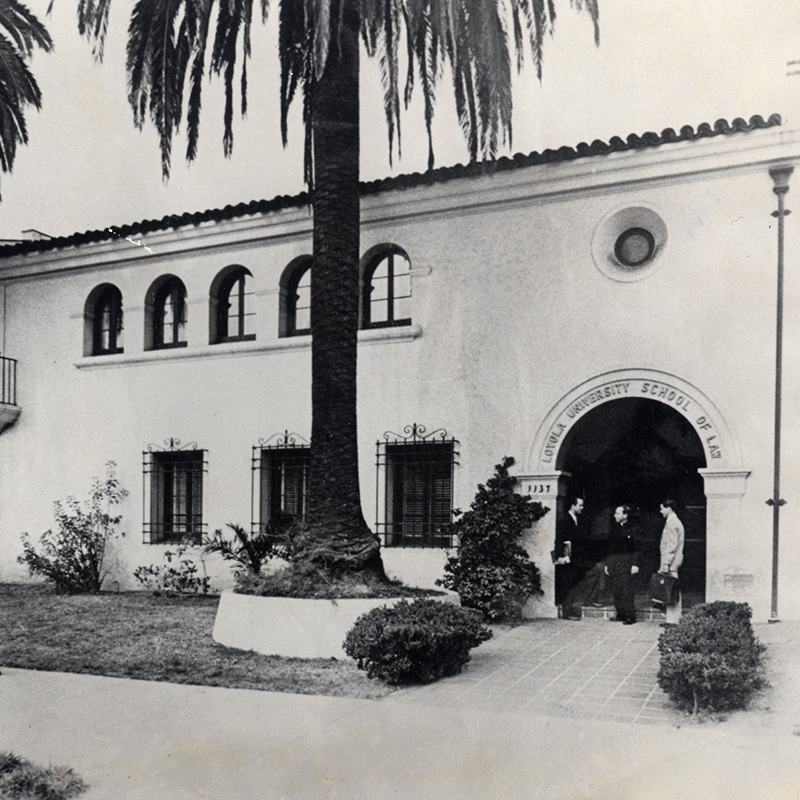
The school remained at its Broadway location only until 1933, when it was decided that the growing school was now too big for one floor of an office building. New space was found in a building on Grand Avenue, near the intersection with 12th Street. The virtues of the new law school location were described as follows in an issue of the Loyola University Bulletin: “The School of Law occupies a modern, two-story building of California Mission Architecture in downtown Los Angeles, within walking distance of the central business district, the Los Angeles Public Library and the County Law Library.”
Photographs of the Grand Avenue building show that it was indeed a very attractive mission style building with large palm trees in front. This structure served the law school for 30 years. Unfortunately, the building was torn down at some point after the law school left to make way for a much larger office building.
1937 was another milestone year for the law school, with two notable accomplishments. First, the school acquired membership in the American Association of Law Schools. Second, the school was granted accreditation by the American Bar Association. The law school had now received the respect it desired and put itself in position to become nationally prominent.
The school was obviously doing well throughout the 1930’s, but world events were about to bring a very great challenge to the law school (as well as all of the nation’s institutions of higher education). When the United States entered World War II, a great demand was made upon college age men. This necessarily meant a dwindling of the pool of law school applicants. To keep the school functioning, Father Donovan and a new Dean, Sayre MacNeil, took several important administrative steps.
First, they combined the day and evening divisions into one program. Second, they created an accelerated option to allow students to take classes year round and thus graduate in two years. Third-and most importantly-women were welcomed back into the law school. While the very first graduating class had included one woman, the school eventually instituted a “ban” upon women applicants. Early in 1943, however, a change in policy was announced and women were invited to again apply to admission to the law school in order to help provide the school with enough students. Clemence Smith (class of 1948) was the first woman readmitted after this change in policy. It is gratifying to know that she eventually became a professor and assistant dean of the law school.
Following the lean years of World War II (there were a mere 6 graduates in 1945), the post-war period represented boom years for the law school, with increased enrollment and recognition. The GI bill meant the school was receiving record numbers of applicants and class sizes increased accordingly. All this growth came at a cost, however. By the late 1950’s, the Grand Avenue building, which had been such an improvement over the school’s earlier locations, was deemed inadequate for the needs of the expanding and ambitious school. It was decided that, once again, the school needed new and improved facilities. Planning began for an entire new campus.
A fundraising campaign led by Fritz Burns and Dean Rex Dibble was launched to convince potential donors of the need for the new campus. The name of this initiative was “Project 70.” The school was able to secure real property at the corner of 9th Street and Valencia and the prestigious architectural firm of Albert C. Martin completed designs. A brochure announcing the plan for the new law campus stated: “The building in which Loyola Law School has been located since 1933 has only 10,000 square feet of floor space and is very poorly arranged for a college facility. Its four classrooms have a total capacity of 188 students. The library cannot accommodate more than 102 students at one time and can only hold some 33,000 volumes. There is no auditorium or assembly room in the building where the law school could hold lectures or programs that would be open to practicing attorneys or other interested members of the community.”
Other criticisms of the Grand Avenue building included a lack of air conditioning and insufficient private office space for faculty members. It is also important to remember that back in the era before online resources, the size and volume count of the law library were very important to legal education.
The new law school building fixed all of these problems. This new, modern building opened in 1964 and was designed specifically to be a law school, a luxury the school had never enjoyed before.